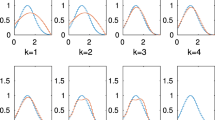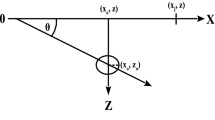Abstract
The Lambert W function is defined to be the multivalued inverse of the function w → we w. It has been widely used in many fields. In this paper, we developed an accurate algorithm for calculating apparent formation conductivity and dielectric constant from electromagnetic logs by making use of Lambert W function. Transforming the complicated nonlinear system into a linear system of much simpler format, this new algorithm can achieve a much higher accuracy of data processing and provide physically meaningful results over the full frequency band of electromagnetic logs. In the frequency band of induction logs (<20 MHz) this algorithm eliminates the complicated procedure for correcting for the skin effects. It also removes the conventional limitation of ωε ≪ σ for induction logs, and therefore, makes accuracy of induction log measurements no longer dependent on the true formation conductivity. In the frequency band of 20–100 MHz, this method can obtain accurate formation conductivities and dielectric constant simultaneously. Theoretical analysis, numerical modeling, and field data processing cases of Oklahoma formation demonstrate the advantages of this new method over traditional methods. The algorithm for this method is easy to implement and it can be used with electronic hardware to produce accurate formation conductivity and dielectric logs directly.
Similar content being viewed by others
REFERENCES
Barber, T. D., 1986, Invasion profiling with the phasor induction tool, in Transaction of the 27thSPWLA annual logging symposium, EE1-EE44.
Corless, R. M., Gonnet, G. H., Hare, D. E., Jeffrey, D. J., and Knuth, D. E., 1996, On the Lambert W Function: Adv. Comput. Math., v. 5, p. 329–359.
Corless, R. M., Jeffrey, D. J., and Knuth, D. E., 1996, A sequence of series for the Lambert W Function, in Proceedings ISSAC '97, p. 197-204.
Duesterhoeft, W. C., 1961, Propagation effects in induction logging: Geophysics, v. 26, no. 2, p. 525–529.
Duesterhoeft, W. C., Hartline, R. E., and Thomsen, H. S., 1961, The effect of coil design on the performance of the induction log: J. Pet. Technol., v. 13, no. 11, p. 1137–1150.
Dyos, C. J., 1987, Inversion of the induction log by the method of maximum entropy, in 28th annual logging symposium, SPWLA, London, England, June, Paper T.
Gianzero, S., and Anderson, B., 1982, A new look at skin effect: Log Anal., v. 23, no. 1, p. 20–34.
Jeffrey, D. J., Hare, D. E., and Corless, R. M., 1996, Unwinding the branches of the Lambert W Function: Math. Sci., v. 21, p. 1–7.
Liu, Y. Y., and Gianzero, S., 1984, Inversion of the induction log using the least squares technique, in Transactions of the 25th SPWLA annual logging symposium, New Orleans, Louisiana, June.
Lyle,W. D., andWilliams, D. M., 1986, Deconvolution of well-logging data: An innovational approach, in Transactions of the 27th SPWLA annual logging symposium, O1-O17.
Moran, J. H., 1982, Induction logging-geometrical factors with skin effect: Log Anal., v. 23, no. 6, p. 4–10.
Zhang, G.-J., 1989, Electrical well logging method (II): Petroleum Industry Press, Beijing, 252 p. (in Chinese).
Author information
Authors and Affiliations
Rights and permissions
About this article
Cite this article
Tao, G., Liu, G. A New Algorithm for Borehole Electromagnetic Measurements Employing Lambert W Function. Mathematical Geology 34, 529–542 (2002). https://doi.org/10.1023/A:1016090827615
Issue Date:
DOI: https://doi.org/10.1023/A:1016090827615




